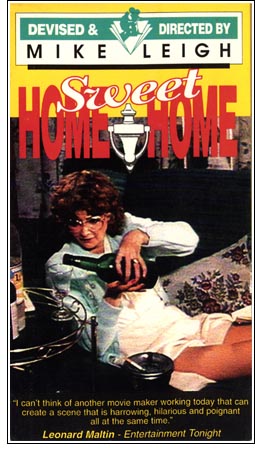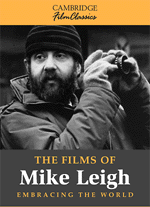|
Though the social and
economic situations of Leigh's characters are invariably specified,
they are not determinative. In his view, institutions don't cause
our problems and institutions cannot solve them. Nothing beyond
the structure of our own thoughts and emotions can be blamed for
our predicament and nothing outside of ourselves can remedy it.
The poorest of Leigh's characters could win the lottery, or the
richest be forced out onto the streets, without their basic dramatic
problems changing.
 One
only has to compare Ken Loach's Ladybird, Ladybird with Leigh's
Home Sweet Home or his short, Probation, for the difference
between the two viewpoints to be clear. Whereas Loach mounts an institutional
critique, the social systems and bureaucracies in Leigh's work are only
individuals writ large. Home Sweet Home dramatizes the relationship
of two social workers, Dave and Melody, to a client, Stan, and his daughter
Tina, but for Leigh the social workers are ultimately just messed-up people.
One might say that while Loach looks at the effect, Leigh studies the
cause. Loach studies bureaucracies; Leigh examines the individual qualities
that make bureaucracies the way they are. The main characters in Ladybird,
Ladybird are victims of a social agency's depersonalizing understandings.
Leigh refuses to make Stan and Tina victims of anybody or anything. Home
Sweet Home makes clear that, even if all of the social workers were
to disappear from the universe, Stan and Tina's relationship would not
improve one whit (and in fact would very likely get worse, since in the
absence of a pushy, intrusive, boorish Melody, Tina would get no visits
or trips home at all). One
only has to compare Ken Loach's Ladybird, Ladybird with Leigh's
Home Sweet Home or his short, Probation, for the difference
between the two viewpoints to be clear. Whereas Loach mounts an institutional
critique, the social systems and bureaucracies in Leigh's work are only
individuals writ large. Home Sweet Home dramatizes the relationship
of two social workers, Dave and Melody, to a client, Stan, and his daughter
Tina, but for Leigh the social workers are ultimately just messed-up people.
One might say that while Loach looks at the effect, Leigh studies the
cause. Loach studies bureaucracies; Leigh examines the individual qualities
that make bureaucracies the way they are. The main characters in Ladybird,
Ladybird are victims of a social agency's depersonalizing understandings.
Leigh refuses to make Stan and Tina victims of anybody or anything. Home
Sweet Home makes clear that, even if all of the social workers were
to disappear from the universe, Stan and Tina's relationship would not
improve one whit (and in fact would very likely get worse, since in the
absence of a pushy, intrusive, boorish Melody, Tina would get no visits
or trips home at all).
There is an ultimate
fairness in Leigh's view of life. We get what we are. Nothing is
inflicted on us (just as nothing outside of ourselves can save us).
We create our own problems and we ourselves must solve them. It
would be hard to imagine a view of experience more at odds with
the blame-games played by most cultural studies critics. Leigh's
characters can never blame anything or anyone–least of all "the system." External forces (figured by ever fashionable
ideological concepts like "power," "gender,"
and "class") have no ultimate authority over what we are.
We are responsible for our own fates. The enemy, if there
is an enemy, is inside. Odd as it may sound to say it, the writers
on cultural studies and neo-Marxist filmmakers like Loach are actually
more optimistic than Leigh, for while the social-work bureaucracy
(Loach's target) may conceivably be reformed, the human heart and
mind (Leigh's subjects) are all too deplorably (and exultantly)
what they are for all eternity. I would argue that the institutional
critique is in fact the simpler, more superficial, and more naive
way of understanding these situations. The labyrinths of the human
heart are far more tortuous and Byzantine than the corridors of
power that constitute the welfare system. The bureaucracies of the
imagination are far subtler and more insidious than those of any
man-made institution. And if you say you don't see that or don't
understand how that could possibly be, why that is precisely what
a work like Home Sweet Home exists to show....
–Excerpted from Ray
Carney, The Films of Mike Leigh: Embracing the World (London
and New York: Cambridge University Press, 2000).
 |
  |
Ray
Carney's The Films of Mike Leigh is quite simply the
best book of film criticism I have ever read.
Now I have to say
that I have never read any of Carney's other books (he has
also written books on Cassavetes, Frank Capra, and Carl Dreyer),
which, for all I know, might be even better. But as a friend
of mine put it, 'His writing blows everything else out there
away, even to the point of many times seeming like simply
in a class of his own...different in kind more than degree.'
And although I admit to not having read 'everything else out
there,' I feel the exact same way. Ray Carney's new book has
undeniably rocked my world.
Ray Carney's book
is to what usually passes for film criticism what Mike Leigh's
movies are to what, in Hollywood, usually passes for filmmaking:
a truly radical critique, a whole different animal, and a
solitary voice of sanity that has somehow miraculously managed
to make itself heard over the noise and hullabaloo of this
culture's present-day insanity. |
|
–Caveh
Zahedi, creator of A Little Stiff and I Don't Hate
Las
Vegas Anymore,
in a review in Filmmaker Magazine |
| |
  |
| |
Mike Leigh’s work is difficult to pin down. Echoing what Ray Carney says of Leigh’s more blinkered characters, examining these films becomes a lot murkier when you bring too many ideas and film-critical categories to bear. Although not without its strengths and serendipities, Garry Watson’s book suffers from intellectual larding while, like one of Leigh’s more far-sighted characters, Carney and Quart’s gets in amongst the rough-and-tumble....
The Carney and Quart book was the first critical study of Leigh’s work and every subsequent book on Leigh must negotiate its rigor and insight. I have yet to read a book that better approximates my experience of watching Leigh’s films.My one regret is that, apart from the important BBC plays Nuts in May and Abigail’s Party (1977), I have yet to see many of the early works wherein Carney locates the wellspring of Leigh’s improvisatory power and vision.
Animating this study is a distinction between two types
of Leigh characters that resonates culturally, politically and
spiritually across his work. For Carney, there are those like
Rupert and Laetitia Boothe-Braine in High Hopes (1988),
Nicola in Life Is Sweet (1990), and Sebastian in Naked (1993)
who, mired in a mental image of themselves, pigeon-hole
others in prejudices, effectively foreclosing on generous and
responsive solidarity. Then there are those like Cyril and
Shirley in High Hopes, Wendy in Life Is Sweet, and Louise in Naked who have all the foibles, strengths, and self-doubts of
their humanity, and are open to the flows of human interaction.
Alison Steadman’s giggly and affectionate Wendy still
epitomizes the principle of social cohesion in Leigh. It is perhaps
unsurprising that Steadman and Leigh were married,
while the positive response to the density of experience recalls
the thick descriptive methodology through which a Leigh
film is arrived at. Evoking the Dickensian and Lawrentian
views of human sensibility (as Watson points out), Leigh feels
that the individual mindset has consequences for the wider
culture, and by this light the generous impulse in Wendy and
other Leigh characters has been eroded by consumerism and
social mobility in postwar Britain. Not as overtly political as
Ken Loach, Leigh has nevertheless chronicled the domestic
consequences of the decline of the social consensus imagined
by writers from Dickens to George Orwell.
One of the most unexpected aspects of Carney and Quart’s book is the way it puts mainstream American cinema in perspective by comparing it with Leigh’s cinema.With his focus on characters as mannered and tic-ridden “outsides” (as opposed to Hollywood’s granting us access to Forrest Gump’s inner kindness despite the goofy exterior), Leigh charts that elusive quality, the “ordinary” moment—the everyday drama of interaction they never show in Hollywood because it occurs between the heroics.
In doing so, Carney shows, Leigh pulls apart the Enlightenment model of agency and volition on which most American movies depend. Recalling classes he has taught—he is Director of Film Studies at Boston University—Carney describes how Americans are often perplexed by a cinema in which nothing seems to happen. But Leigh’s drama of transformation is rooted in the layered rehearsal of interpersonal dynamics observed with the patience of a European Ozu. Whilst British Leigh commentators have been preoccupied with the writer-director’s purchase on the sociological landscape, Carney convinces us that Leigh and Ozu share a feeling for the interplay of performance and mise-en-scène which moves beyond David Bordwell’s pioneering Ozu dichotomy between modernism and tradition. Leigh’s conception of experience (unlike that of Hollywood) is durational rather than deadlined, heterogeneous rather than hurried. Carney’s examination of space and time in Leigh reveals, as Bordwell has done elsewhere, that the mainstream model of experience conceals as much as it reveals.... |
| |
–Richard Armstrong, a review of Gary Watson, The Cinema of Mike Leigh and Ray Carney and Leonard Quart, The Films of Mike Leigh: Embracing the World, published in Film Quarterly, Dec 2005, Vol. 59, No. 2, pp. 62-63 |
| |
  |
| |
No other study sheds such a revealing light on Leigh's background, his influences, his emotional groundings, and, of course, his unique cinematic sensibility....[Carney's The Films of Mike Leigh is a] powerful and multifaceted analysis which welcomes, like Leigh's work, the vibrant eye and the uncalcified consciousness.
|
| |
-- Andrew Hamlin, in a review of Ray Carney's The Films of Mike Leigh: Embracing the World, published in MovieMaker Magazine. |
| To learn
how to obtain this book, click
here |
|










